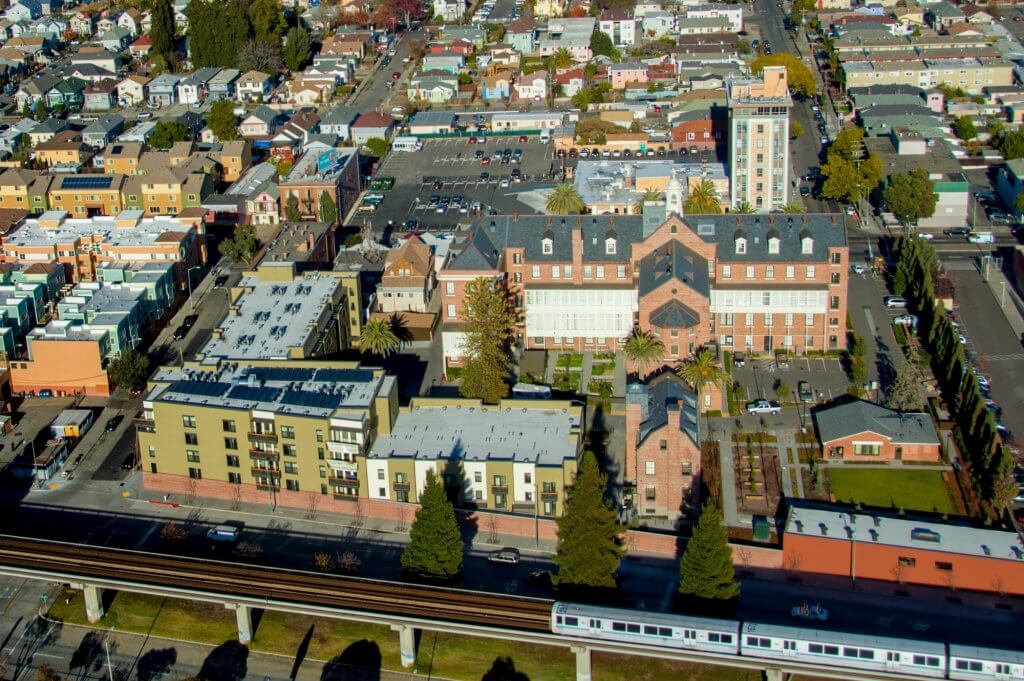California Steps Forward for Housing
Published On September 20, 2017
On Friday, September 15th, the California legislative session ended with the passage of 17 individual pieces of legislation aimed at alleviating the state’s ongoing housing crisis. While three particular bills have received the most attention—SB2, SB3, and SB35—several other bills headed for the Governor’s desk are also likely to have an important impact on the landscape of the state’s housing policy.
We have compiled a brief overview of each bill that passed, organized into policy categories. While the passage of these newly approved policies is certainly a milestone, we also know there is much more work ahead.
Stay tuned for another post in the coming days that will lay out and discuss the broad policy issues that remain and must be addressed to ensure lasting, meaningful change for housing in the state of California.
NEW FUNDING
Affordable housing funds have become increasingly difficult to obtain as various sources of financing have dwindled in recent years, severely hampering the ability to produce new, affordable housing. Thankfully, the latest round of legislation includes a new dedicated source of funding and the possibility of billions of dollars with the approval of voters.
SB2 (ATKINS)
The Building Homes and Jobs Act imposes a fee of $75 at the time of the recording of every real estate instrument, paper, or notice required or permitted by law to be recorded, per each single transaction per single parcel of real property, not to exceed $225. This fee excludes any recording made in connection with a sale of real property, including single family home purchases and sales.
The bill allocates the funding over two time periods. In 2018, 50% of the funding will be made available to local governments to update planning documents and zoning ordinances in order to streamline housing production, and 50% to HCD to assist persons experiencing or at risk of homelessness, including, but not limited to, providing rapid rehousing, rental assistance, navigation centers, and the new construction, rehabilitation, and preservation of permanent and transitional rental housing.
Beginning in 2019, 70% of funding will be allocated to cities in accordance with a specified formula and used for the creation of affordable housing (up to 120% of AMI) or homeless housing, including necessary operating subsidies.
The remaining 30% will be made available to HCD for specified purposes, including a continuous appropriation of moneys to the California Housing Finance Agency for the purpose of creating mixed income multifamily residential housing for lower to moderate income households, as provided.
Cities must have compliant housing elements to receive SB2 funds.
SB3 (BEALL)
The Veterans and Affordable Housing Bond Act of 2018 would authorize the issuance of $4,000,000,000 in bonds pending the outcome of the Nov 6, 2018 ballot initiative.
$3,000,000,000 would be used to finance various existing housing programs, including:
- $1,500,000,000 to fund the Multifamily Housing Program.
- $150,000,000 for the Transit-Oriented Development Implementation Fund to provide assistance to cities, transit agencies, and developers for the purpose of developing or facilitating the development of higher-density uses within close proximity to transit stations.
- $300,000,000 for the Regional Planning, Housing, and Infill Incentive Account, for infill incentive grants to assist in the new construction and rehabilitation of infrastructure that supports high-density affordable and mixed-income housing in locations designated as infill, including, but not limited to: park creation, development, or rehabilitation to encourage infill development; water, sewer, or other public infrastructure costs associated with infill development; transportation improvements related to infill development projects, and; traffic mitigation.
- $150,000,000 for the Self-Help Housing Fund for the home purchase assistance program.
- $300,000,000 for the Joe Serna, Jr. Farmworker Housing Grant Fund.
- $300,000,000 for the Affordable Housing Innovation Fund for competitive grants or loans to local housing trust funds that develop, own, lend, or invest in affordable housing. Used to create pilot programs to demonstrate innovative, cost-saving approaches to creating or preserving affordable housing.
- $300,000,000 for the Self Help Housing Fund through Cal Home to provide direct, forgivable loans to assist development projects involving multiple home ownership units, including single-family subdivisions; for self-help mortgage assistance programs; and for manufactured homes. At least thirty million dollars ($30,000,000) is to be used to provide grants or forgivable loans to assist in the rehabilitation or replacement of existing mobile homes located in a mobile home or manufactured home community.
- $1,000,000,000 for farm, home, and mobile home purchase assistance for veterans.
APPROVAL STREAMLINING AND ACCOUNTABILITY
New funding for housing is ineffective without improvements to the housing approval process. To that point, several pieces of legislation passed as part of the housing package provide pathways to approval streamlining. Additional legislation would implement new rules to enforce each city’s existing housing policies and ensure these policies are designed in such a manner that does not deter reasonable housing development.
SB35 (WIENER)
Allows development project applicants to qualify for ministerial approval of a project provided that the city is not currently meeting their RHNA goals (applicable when the number of issued building permits is less than the locality’s share of the regional housing needs, by income category). Projects must meet all applicable zoning standards for the city, locate in an infill location, include at least 10% of affordable units, and (if more than 10 units) pay a prevailing wage. Additionally, the bill requires HCD to post an annual report showing the status of each city’s housing element plans, the progress in meeting its share of regional housing needs, and the number of net new units of housing that has been issued an entitlement, building permit, or certificate of occupancy, among other things.
SB166 (SKINNER)
Prohibits cities from permitting or causing its inventory of sites identified in the housing element to be insufficient to meet its remaining unmet share of the regional housing need for lower and moderate-income households. If sites are removed or projects approved at lower densities than identified in the housing element, the city must designate other areas within the city to account for the loss of space.
SB167 (SKINNER)/AB678 (BOCANEGRA)
The Housing Accountability Act prohibits cities from denying projects or approving them in a manner that renders them infeasible, provided that projects comply with their existing ordinances and general plan policies. It allows applicants to bring claims against cities and recoup reasonable attorney’s fees as well.
The act authorizes the courts to impose fines of at least $10,000 per unit if they find that the city acted in bad faith. Those fines must be deposited in either a local housing trust fund or into the state’s SB2 fund (Building Homes and Jobs) of the Housing Rehabilitation Loan Fund. If deposited into a local fund, those funds must be spent on affordable housing within five years. The failure to do so results in those funds reverting to the state as described above.
SB229 (WIECKOWSKI)/AB494 (BLOOM)
Authorizes cities to create ordinances to allow for accessory dwelling units (ADUs) in single family zoned areas and sets a maximum of one parking spot required per unit, regardless of the number of bedrooms. In addition, these bills prohibit categorizing ADUs as new residential uses for the purposes of calculating local agency connection fees or capacity charges for utilities that may be levied by special districts or water corporations.
AB72 (SANTIAGO, CHIU)
Requires HCD to review any action or failure to act by the city that it determines is inconsistent with its housing element. The bill also authorizes HCD to notify the Office of the Attorney General that the city is in violation of state law if HCD determines a city is in noncompliance or in violation of its housing element.
AB879 (GRAYSON)
Requires a city’s housing element analysis of governmental constraints to include any local ordinances that directly impacts the cost and supply of residential development. This bill also requires a city’s housing element analysis of nongovernmental constraints to include requests to develop housing at densities below those anticipated in a specified analysis, and the length of time between receiving approval for a housing development and submittal of an application for building permits for that housing development that hinder the construction of a locality’s share of the regional housing need. This bill requires the analysis of nongovernmental constraints to demonstrate local efforts to remove these constraints
Additionally, this bill commissions HCD to complete a study evaluating the reasonableness of local fees charged to new developments and must include findings and recommendations for potential amendments to the Mitigation Fee Act to substantially reduce fees for residential development. The study must be completed by Jun 30, 2019.
AB1515 (DALY)
Specifies that a housing development project or emergency shelter be deemed consistent, compliant, and in conformity with an applicable plan, program, policy, ordinance, standard, requirement, or other similar provision if there is substantial evidence that would allow a reasonable person to conclude that the housing development project or emergency shelter is consistent, compliant, or in conformity.
AB1397 (LOW)
Adds several requirements to the housing element’s inventory of land suitable for residential development. Vacant sites identified in the housing element must have a realistic and demonstrated potential for development in order to be counted toward accommodating a portion of the locality’s housing need for a designated income level. Parcels included in the inventory must have sufficient water, sewer and dry utilities sufficient to support housing development or be included in a program to secure such services.
INCENTIVIZING CITIES
Cities should be given the tools necessary to set the table for creating new housing. A handful of new tools will be created to incentivize cities to plan for and prioritize sensible housing.
SB540 (ROTH)
Authorizes cities to establish “Workforce Housing Opportunity Zones” which would conduct EIRs and specific plans to streamline development in these zones. Cities can apply for grants and no-interest loans from HCD to complete the environmental and planning work. Projects within the zone must be approved within 60 days of the application being deemed complete provided that it is consistent with the specific plan. To be eligible, 30 percent of units must be sold or rented to moderate income households, 15 percent must be sold or rented to lower income households, and 5 percent must be sold or rented to very low income households. Further, no more than 50 percent of the total units constructed in the zone shall be sold or rented to persons and families of above moderate income. Projects within the zone are subject to prevailing wage.
AB73 (CHIU)
Incentivizes cities to create “Housing Sustainability Districts” that would conduct an upfront EIR and approve ministerial permits within 120 days for housing projects within the district. Cities are given “incentive payments” for setting up the district, with half of the incentive paid once the district is approved, and the other half upon verification by HCD of the issuance of permits for the projected units of residential construction within the district. The amount of these payments is unclear, as they still would need to be appropriated by the legislature. Payment is tied to number of units constructed within the district.
Areas eligible for a “Housing Sustainability District” must be in an area either 1) located within ½ mile of public transit, or 2) is highly suitable for a residential or mixed-use housing sustainability district by virtue of existing infrastructure, transportation access, existing underutilized facilities, or location. The area must also be zoned to permit residential use through the ministerial issuance of a permit, and must be zoned at a higher density.
At least 20 percent of the residential units constructed within the district must be affordable to very low, low-, and moderate-income households and subject to a recorded affordability restriction for at least 55 years. District projects are subject to prevailing wage requirements (unless they include 10 or fewer units).
AB1568 (BLOOM)
The Neighborhood Infill Finance and Transit Improvements Act allows cities to allocate specified tax revenues to an existing or future “Enhanced Infrastructure Financing District” or “Community Revitalization Investment Authority.” Previously, only property taxes were included for these programs. 20% of funding must be used for affordable housing.
AFFORDABILITY PROTECTIONS
In addition to new supply, maintaining existing affordability was also addressed in the housing package, as well as creating a new supply through city-level ordinances on market rate development.
AB1193 (GLORIA)
Allows affordable housing developments to continue to qualify for the welfare property tax exemption if tenants meet the federal income requirements. Under existing property tax law, affordable housing property is entitled to a partial property tax exemption. This bill allows the property tax exemption to continue for a unit until the occupant’s income reaches 140% AMI, which is the federal limit for affordability.
AB1505 (BLOOM, CHIU, GLORIA)
Allows cities to impose ordinances mandating a residential development to include a certain percentage of affordable units. If that percentage of affordable units exceeds 15%, a city must provide evidence that the ordinance does not unduly constrain the production of housing by submitting an economic feasibility study conducted by a qualified entity with demonstrated experience in the area, and follow methodological best practices. If a city fails to provide evidence or the evidence is deemed insufficient, the city must revert to 15% or less for their requirement. The ordinance must also provide alternative means of compliance that may include in-lieu fees, land dedication, off-site construction, or acquisition and rehabilitation of existing units.
AB1521 (BLOOM, CHIU)
Requires owners of expiring affordable rental projects to accept purchase offers from any qualified operator of affordable housing, provided that the operator intends to maintain the affordability restriction of the property. The market rate purchase price would be determined by negotiation and agreement between the parties, or failing an agreement between the parties, an appraisal initiated by the owner.
AB571 (E. GARCIA)
Updates the Farmworker Housing Assistance Tax Credit Program to encourage higher usage and leverage of federal tax-exempt bonds and the 4% low-income housing tax credit program. The bill authorizes HCD to provide advance payments of up to 20% of annual operating costs of migrant farm labor centers to contractors. Also, this bill removes the law’s existing limitation that funds appropriated or authorized to fund the cost of subsidizing occupancy periods be for the first 14 days only and prohibits the standard 180-day occupancy period combined with any extended occupancy period under these provisions from exceeding a cumulative operating period of 275 days in any calendar year.





